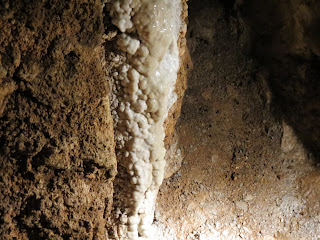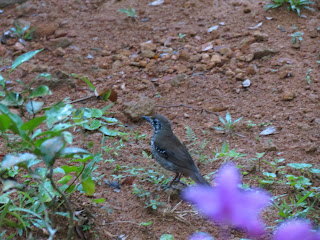It took us about an hour to finish the track. It lead through eucalypt forest and rainforest where brown thornbills, crimson rosellas, red wattlebirds and Eastern yellow robins were abundant. Less common were lyrebirds, and we couldn't see a single one. Then, as we were walking back along the track, my dad yelled out "Chanith, there's a lyrebird!" The superb lyrebird, a lifer, darted into the bush too quickly to get a photo. It didn't matter, we would soon get another chance.
These eastern yellow robins were everywhere
After eating a buffet breakfast we left the hotel, driving to the Jenolan Caves. These caves were not only beautiful, they were surrounded by trails good for 'spotting shy native wildlife', and they were a home of eastern bentwing and eastern horseshoe bats. A great photo opportunity. It took us a while, but eventually we got to the caves. We passed through a majestic cave with a road in the middle of it. In this trails were all around, heading to the different caves. We drove over to the carpark, around which there were many pied currawongs. We walked past a picnic ground and there, in the bush, was a female superb lyrebird!
My first photo of a superb lyrebird, and my second sighting
After that we went down to the village and bought some maltesers before going on our first cave tour, the Lucas Cave tour. It was beautiful! Calcite stalagtites, columns and stalagmites were everywhere in this amazing limestone cave! We even saw the perfectly blue-green waters of the underground River Styx, named after the river of the underworld in Greek mythology, at one point. These photos really do not capture the wonder.
The broken column, the most photographed feature in the Jenolan Caves
This gooey mass of white is actually a bunch of wet calcite crystals
These strange formations are known as shawls, or cave bacon. That brown material is actually calcite, it is just covered by a lot of mud and dirt
After the hour and a half-long tour we stopped back at the village and ate lunch at the bistro. Outside the bistro I spotted very tame crimson rosellas and pied currawongs which came up to scavenge on scraps left under the tables. Less tame were some superb fairy-wrens hopping about in the bush.
A crimson rosella having lunch under a chair
After this my sister and I went on the kids tour, while my parents went on a tour of the Imperial Cave. The kids tour first passed through Chiffley Cave, where we were trying to see eastern bentwing bats. However, we did not manage to see them. Instead, we saw some more calcite formations, some springtails on a fallen stalagtite and the skeleton of a dead bat which had been covered by crystal.
This poor little bentwing bat was flying through the cave when it hit calcite. Over the years crystal grew over its skeleton and it can now be seen stuck to the wall of the cave
Some dry calcite formations. Formations like this are very common in the Jenolan Caves
After that we went further on into Imperial Cave and saw the beauty of the River Styx. Apparently no cave fish live in this river, though the occasional short-finned eel visits (the river is connected to a blue lake on the surface).
The perfectly blue-green waters of the River Styx
The reason this light looks so old fashioned is because it was placed in the early 1900s.
After exploring part of the Imperial Cave and seeing a few fossils we then headed up to the surface to the perfectly blue lake the River Styx flows into, and where a lot of Sydney's drinking water comes from. This can often be a great place to see platypus, but someone was throwing rocks into the water and so we didn't see anything. I did, however, hear brown thornbills near the lake. There were no waterbirds on the lake. After that we drove back to Sydney and the airport, stopping to see a pair of red-necked wallabies that were next to the road.
A red-necked wallaby, one of the three commonest/most noticeable macropods in the Blue Mountains (red-necked wallaby, swamp wallaby, eastern grey kangaroo). Brush-tailed rock wallabies used to be on that list but now there are only about 15 left in the mountains.








































